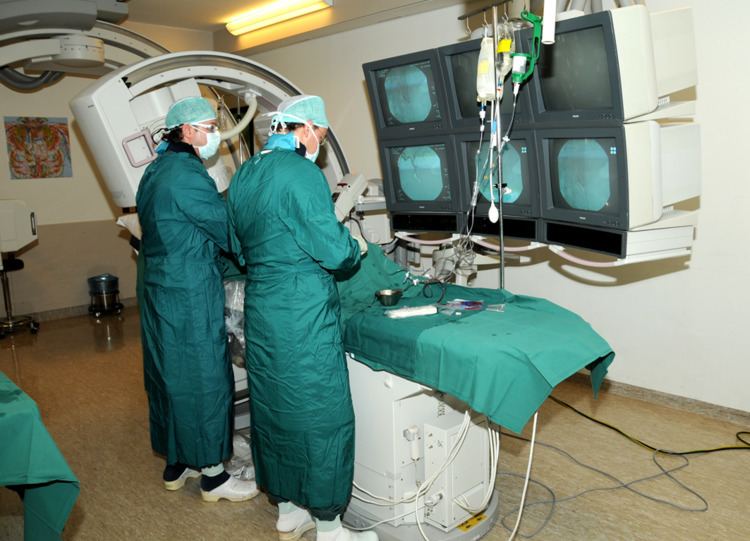 | ||
Selective internal radiation therapy (SIRT) is a form of radiation therapy used in interventional radiology to treat cancer. It is generally for selected patients with unresectable cancers, those that cannot be treated surgically, especially hepatic cell carcinoma or metastasis to the liver. The treatment involves injecting tiny microspheres of radioactive material into the arteries that supply the tumor. Because this treatment combines radiotherapy with embolization, it is also called radioembolization. The chemotherapeutic analogue (combining chemotherapy with embolization) is called chemoembolization, of which transcatheter arterial chemoembolization is the usual form.
Contents
Principles
Radiation therapy is used to kill cancer cells; however, normal cells are also damaged in the process. Currently, therapeutic doses of radiation can be targeted to tumors with great accuracy using linear accelerators (see radiation oncology); however, the normal liver tissue is very sensitive to external beam radiotherapy. Fortunately, malignancies (including primary and metastatic liver cancers) are often hypervascular; tumor blood supplies are often increased compared to those of normal tissue. Furthermore, the liver has a dual blood supply, receiving blood from both the hepatic artery and the portal vein. Hepatic malignancies derive most of their blood supply from the hepatic artery; whereas the normal liver derives most of its blood supply from the portal vein. Therefore, delivery of radioembolic particles through the branch of the hepatic artery supplying a tumor will preferentially lead to deposition of the particles in the tumor, while sparing normal liver from harmful side effects.
Therapeutic Applications
Patients who are candidates for radioembolization include those with:
1) unresectable primary liver cancer or metastatic cancer (colorectal cancer, neuroendocrine tumor )2) liver-dominant tumor burden3) life expectancy of at least 3 monthsA phase III trial (SIRT versus sorafenib) is in progress.
Procedure
Y-90 microsphere treatment requires patient-individualized planning with cross-sectional imaging and arteriograms. Contrast computed tomography and/or contrast-enhanced magnetic resonance imaging of the liver is required to assess tumor and normal liver volumes, portal vein status, and extrahepatic tumor burden. Hepatic and renal function tests should be performed; patients with irreversibly elevated serum bilirubin are excluded, and iodinated contrast use should be avoided or minimized in patients with renal insufficiency. Tumor marker levels are also evaluated. Hepatic artery technetium (99mTc) albumin aggregated (MAA) scan is performed to evaluate hepatopulmonary shunting (resulting from hepatopulmonary syndrome). Increased pulmonary shunt fraction (>20%) indicates an increased likelihood of the radioactive particles traveling to the lung during therapy, leading to the adverse side effect of radiation pneumonitis.
The initial angiographic evaluation can include an abdominal aortogram, Superior mesenteric and Celiac arteriograms, and selective right and left hepatic arteriograms. These studies allow for documentation of the gastrointestinal vascular anatomy and flow characteristics. Extrahepatic vessels found on angiographic evaluation are often embolized in order to prevent nontarget deposition of microspheres, that can lead to gastrointestinal ulceration. Once the branch of the hepatic artery supplying the tumor is identified and the tip of the catheter is selectively placed within the artery, the 90Y microspheres are infused.
After treatment, Bremsstrahlung scanning may be performed within 24 hours after radioembolization to evaluate the distribution of the Y-90 microspheres. Weeks after treatment, computed tomography or MRI can performed to evaluate anatomic changes, and positron emission tomography may also be performed to evaluate changes in metabolic activity.
Agents
The microspheres themselves are made of glass or resin. Inside the microspheres is the isotope yttrium-90, which has beta-emission with a half-life of 2.6 days. Currently there are 2 types of microspheres: TheraSphere and SIR-Spheres, which differ in their radioactivity per sphere and embolic effect.
:
Adverse effects
Complications include postradioembolization syndrome (PRS), hepatic complications, biliary complications, portal hypertension, radiation pneumonitis, gastrointestinal ulcers, vascular injury, and lymphopenia.
Postradioembolization syndrome (PRS) includes fatigue, nausea, vomiting, anorexia, fever, abdominal discomfort, and cachexia, occurring in 20-55% of patients. Steroids and antiemetic agents may decrease the incidence of PRS.
Hepatic complications include hepatic fibrosis leading to portal hypertension, radiation-induced liver disease (RILD), transient elevations in liver enzymes, and fulminant liver failure.
Biliary complications include cholecystitis and biliary strictures.
History
Investigations using yttrium-90 (90Y, Y-90) and other radioisotopes for cancer treatment began in the 1960s. Reports of the initial use of resin particles of Y-90 in humans were published in the late 1970s. In the 1980s, the safety and feasibility of Y-90 microsphere therapy for liver cancer were validated in a canine model. Clinical trials of Y-90 applied to the liver continued throughout the late 1980s to the 1990s, establishing the safety of the therapy. More recently, larger trials and RCTs have demonstrated safety and efficacy of Y-90 therapy for the treatment of both primary and metastatic liver malignancies.
